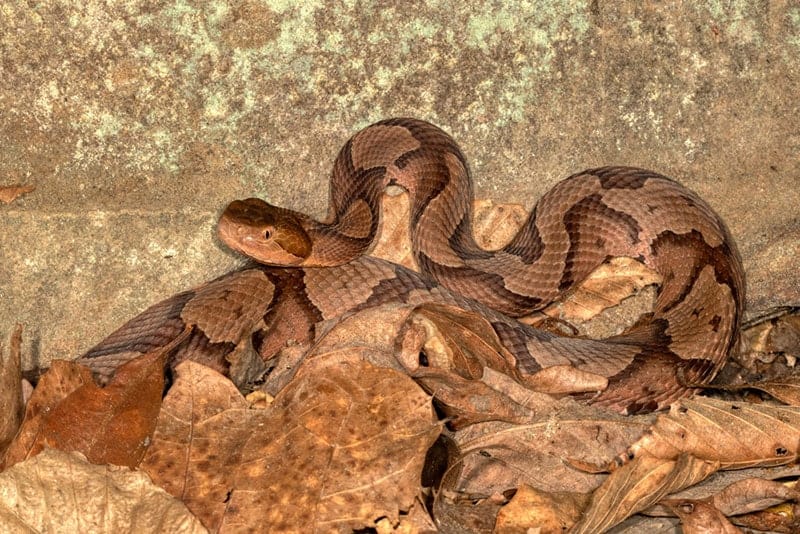Kansas is known as the Sunflower State, comprised of an area in the Great Plains of North America. While this midwestern state is hailed as being the nation’s leading wheat producer, Kansas also boasts having over 40 species of snakes and they’re the most diverse group of reptiles in the state.
There are several different water snakes in this state as well as a few venomous snakes in Kansas. Whether you’re from Kansas or are planning a visit there to explore the great outdoors, it’s always good to know what snakes you may encounter when roaming around the state.
Below we’ve listed some of the most common snakes found in Kansas, along with some interesting information about each type so you’ll know what to watch for when you’re out exploring the great outdoors.

The 10 Snakes Found in Kansas
1. Prairie Rattlesnake

| Species: | C. viridis |
| Adult size: | 36 – 48 inches |
| Appearance: | Triangular head, light brown body covered in dark blotches that gradually turn into rings near the tail. |
| Venomous: | Yes |
| Diet: | Rodents, other snakes, lizards, rabbits, prairie dogs, ground-nesting birds |
Found in the western half of the state, the Prairie Rattlesnake is one of the few venomous snakes in Kansas. This snake is best known for the unique rings on the end of its tail that make a rattling sound. This heavy-bodied snake is not aggressive although it will strike out if it feels threatened.
The Prairie Rattlesnake has a heat-sensitive pit on each side of its head it uses to track prey.
When this snake gets close to prey, its venomous fangs fold down from the roof of its mouth to strike and inject venom to weaken the prey. Once the animal dies, the Prairie Rattlesnake will eat it whole.
This incredibly venomous snake’s bite can be fatal if left untreated as the venom destroys tissue and blood cells which can result in internal hemorrhaging. Thankfully, few people are bitten by Prairie Rattlesnakes as these snakes tend to flee when they sense danger.
2. Eastern Racer

| Species: | C. constrictor |
| Adult size: | 20 – 56 inches |
| Appearance: | Slate gray to black body with a whitish underbelly |
| Venomous: | No |
| Diet: | Birds, bird eggs, lizards, frogs, toads, lizards, insects |
The Eastern Racer is a commonly found snake in Kansas that’s known for being a fast mover. These are alert and curious snakes with excellent vision that can sometimes be seen raising their heads above the top of grass to view what is around them.
The Eastern Racer is very fast and typically flees when it feels threatened. However, if this non-venomous snake feels cornered, it will put up a fierce fight and bite hard and often. This snake is difficult for humans to handle as it writhes, defecates, and releases a foul smell.
This snake is commonly found near water but can also be found in brush, trash piles, ditches, and residential areas. While it spends most of its time on the ground, this snake has no problem climbing a tree to snatch eggs or chicks from bird nests.
3. Northern Water Snake

| Species: | N. sipedon |
| Adult size: | 42 – 55 inches |
| Appearance: | Long body with varying shades of gray, tan, or brown with dark bands |
| Venomous: | No |
| Diet: | Frogs, fish, crayfish, salamanders, small birds, worms, leeches |
The Northern Water Snake is one of the water snakes in Kansas that can be seen in many lakes, rivers, and streams across the state. This medium-sized snake’s body can be varying shades of gray, tan, or brown with dark bands which lead many people to mistake them for aggressive Water Moccasins. However, the Northern Water Snake is not venomous but it can flatten its body and bite when agitated so it’s best to leave this snake alone if you encounter one in the wild.
The Northern Water Snake swallows its prey alive and feeds on a wide variety of fish, frogs, toads, crayfish, and tadpoles. It is common to spot Northern Water Snakes during the summer coiled up and basking in the sun on stream banks or atop rocks, stumps, or brush. The Northern Water Snake doesn’t lay eggs like many other snakes. This is an ovoviviparous snake that gives birth to free-living young.
4. Timber Rattlesnake

| Species: | C. horridus |
| Adult size: | 35 – 40 inches |
| Appearance: | Brown to gray body with a dark zig-zag pattern |
| Venomous: | Yes |
| Diet: | Small mammals, rodents, frogs, small birds, other snakes |
Of all the venomous snakes in Kansas, the Timber Rattlesnake has the most potent venom. Most people who are bitten by Timber Rattlesnakes surprise the snakes wherein they strike out and bite. However, this snake is shy and docile and only bites when provoked.
During the spring and fall, the Timber Rattlesnake is diurnal but it hunts at night during the summer months to avoid the high daytime temperatures. While this snake travels several yards during the day in search of food, it spends long periods coiled up and immobile, waiting patiently for prey to approach. An interesting fact about these snakes is that the females of the species don’t feed during pregnancy as they rely on fat storage to maintain themselves.
The Timber Rattlesnake is only found in the eastern third of Kansas in heavily vegetated, rocky outcrops on partially treed hillsides. You could walk right past one of these docile snakes without knowing it as they often lay motionless and quiet to avoid being seen.
5. Plains Milk Snake
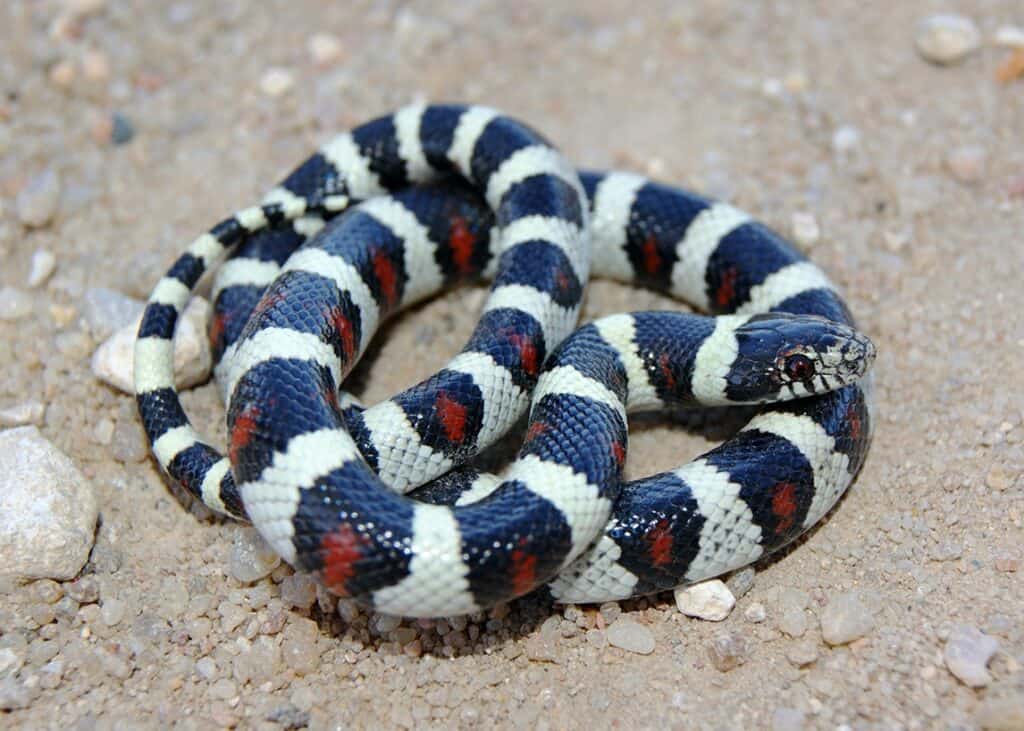
| Species: | L. triangulum |
| Adult size: | 24 – 34 inches |
| Appearance: | Red, black, yellow bands of color on the body |
| Venomous: | No |
| Diet: | Small mammals, lizards, birds, bird eggs, frogs, other snakes |
The striking Plains Milk Snake features a body with red, black, and yellow banding to confuse its predators into thinking it’s venomous. This snake can be found throughout Kansas in open prairies and forested regions. It’s a mostly nocturnal snake, especially during the summertime when the temperatures rise.
This colorful snake spends most of its time on the ground trying to blend in with ground litter while searching for prey. Plains Milk Snakes tend to be secretive and remain hidden. If one of these snakes feels threatened, it will try to escape. But if it is cornered or harassed, it will vibrate its tail and strike out. Thankfully this is a non-venomous snake that has tiny teeth, even though the snake wants you to think otherwise!
6. Coachwhip Snake
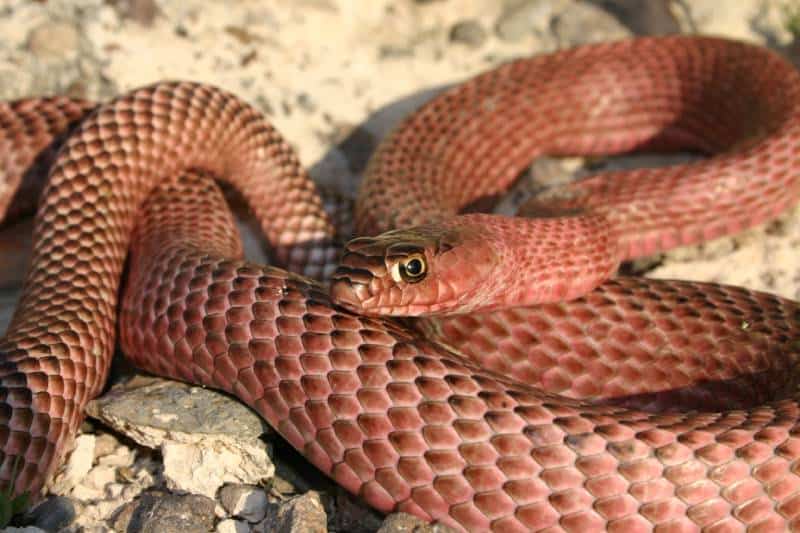
| Species: | M. flagellum |
| Adult size: | 50 – 72 inches |
| Appearance: | Slender light gray to brown body with a small head and large eyes |
| Venomous: | No |
| Diet: | Lizards, small rodents, small birds, other snakes |
The slender Coachwhip Snake can be found in open areas with sandy soil in pine forests, fields, and prairies in the southern and western regions of Kansas. This snake is diurnal and actively hunts and eats lizards, small birds, rodents, and other snakes.
Although the Coachwhip is one of the non-venomous snakes in Kansas, its bite can be painful. However, it’s not likely that you’ll be bitten by one of these snakes as they’re quick to take off when they feel threatened. This snake is easy to identify by its light gray to light brown color, thin body, small head, large eyes, and round pupils.
7. Gopher Snake
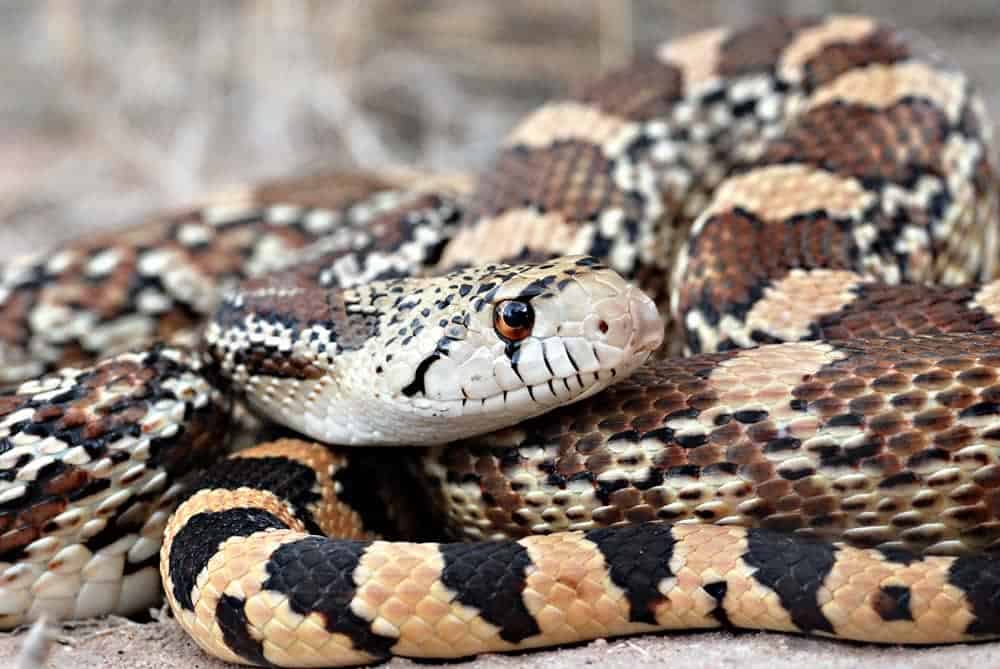
| Species: | P. catenifer |
| Adult size: | 37 – 72 inches |
| Appearance: | Long and muscular cream to light brown body with dark blotches on its back and small dark spots on its side. |
| Venomous: | No |
| Diet: | Rodents including voles, rats, pocket gophers, young prairie dogs |
The Gopher Snake, which is also called the Bull Snake, is a non-venomous snake found in the central and western prairies and woodlands of Kansas. This is the largest snake in Kansas that can reach 6-feet in length or longer. Even though this snake looks dangerous, it’s considered to be the most economically beneficial snake in the state because it preys on rodents found around grain storage areas.
Gopher Snakes mimic rattlesnakes except they hiss instead of rattle. Unfortunately, many of these snakes are killed because they’re mistaken for rattlesnakes. The Gopher Snake is a large and powerfully built snake that can scare the daylights out of you if you come across one. But if you quietly walk on by, this snake is likely to ignore you or flee for cover.
8. Cottonmouth Snake
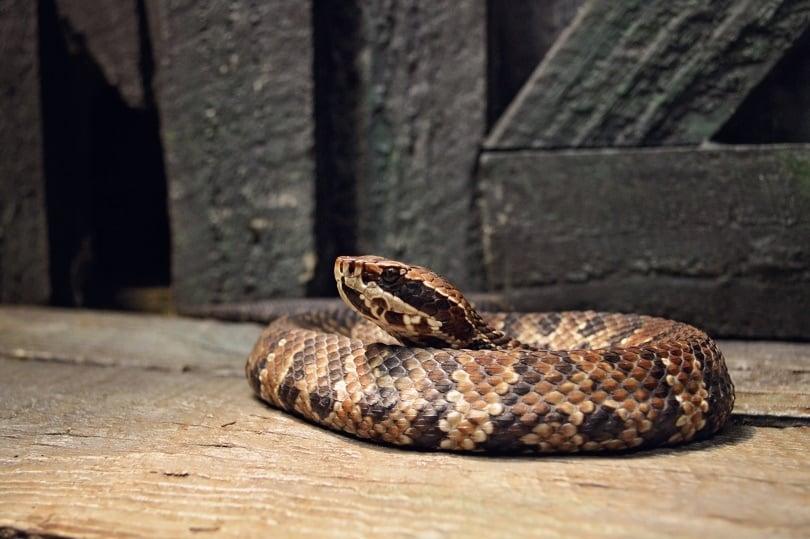
| Species: | A. piscivorus |
| Adult size: | 26 – 35 inches |
| Appearance: | Brown or blackish color on body with dark brown crossbands with black edges |
| Venomous: | Yes |
| Diet: | Small mammals, rodents, amphibians, fish, birds, other snakes |
The venomous Cottonmouth Snake is rarely found in Kansas and when it is, it’s typically only seen in Cherokee County, which is in the southeastern part of the state. This snake is a species of pit viper and is the only semi-aquatic viper native to the United States. This snake can be found in or near water in shallow lakes, creeks, and marshy areas.
A Cottonmouth gets its name from how it displays when threatened. This snake will stand its ground, throw its head back, and gape at an intruder, exposing the shocking white lining of its mouth. A Cottonmouth bite not only hurts, but it can be potentially fatal. While deaths from Cottonmouth bites are rare, a bite from this snake can leave a scar and even on occasion, require amputation as the powerful venom is very destructive to the human body’s tissue.
9. Eastern Hognose Snake
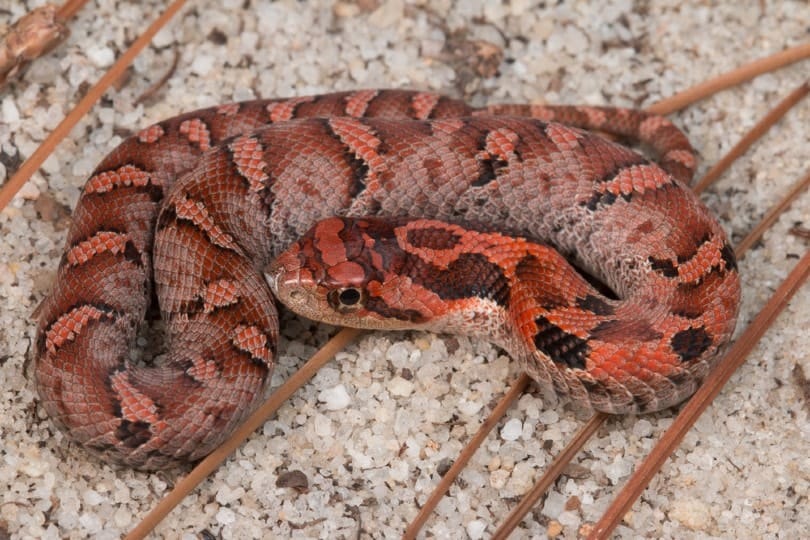
| Species: | H. platirhinos |
| Adult size: | 26 – 36 inches |
| Appearance: | Yellow, brown, tan, reddish. or gray thick body with dark brown blotches down the back and an up-turned snout |
| Venomous: | No |
| Diet: | Frogs and toads |
The Eastern Hognose is found in forested areas of eastern Kansas west along major streams to the Colorado border. This snake tends to live in sandy areas along valleys of big rivers. While this snake is not venomous and rarely bites, it can give you a big scare with its defensive behavior.
When it feels threatened or cornered, the Eastern Hognose spreads its hood like a cobra, hisses, and lunges at the intruder, and eventually rolls over and plays dead! If someone attempts to pick up an Eastern Hognose, the snake will spray musk vigorously and then fake death if it’s not put down.
The Eastern Hognose hunts and eats mainly toads although it will gladly eat frogs if it can catch them. This snake with the amazing repertoire of defensive behavior is a relatively rare sight in Kansas as it spends much of its time trying to stay out of sight.
10. Copperhead Snake
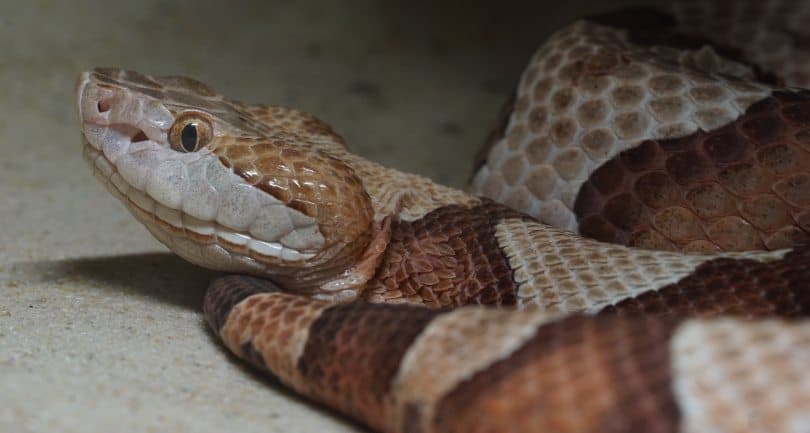
| Species: | A. contortrix |
| Adult size: | 20 – 37 inches |
| Appearance: | Pale tan color on a relatively stout body with cross bands that are light tan and darker toward the edges. This snake has a broad bronze-hued head that’s distinct from the neck. |
| Venomous: | Yes |
| Diet: | Mice, shrews, moles, small birds, lizards, frogs |
The Copperhead is a venomous snake that is fairly common in the eastern part of Kansas, living in open prairies and along forest edges. These snakes can also tolerate living in urban areas and on developed land, making interactions with people relatively common.
Thankfully, the Copperhead’s venom is not among the most potent and the snake’s bite is rarely deadly. These snakes are a type of pit viper with small indentations between their eyes and nostrils that help them sense heat for successfully hunting prey during the night when they’re most active. When this snake bites its prey, it will hold the animal in its mouth until the venom kills it, then the prey is swallowed whole.

Conclusion
The snakes listed here are among the many creatures you may encounter while hiking the Kansas prairies, canyons, and forests. The snakes living in the Sunflower States are an integral part of the ecosystem and they’re typically shy animals that are frightened by people.
If you encounter a snake, whether it’s one of the water snakes in Kansas, a venomous species, or a completely harmless one, show some respect and give the snake room. Snakes don’t like meeting up with people any more than most people don’t like coming face-to-face with a wild snake!
- You may also be interested in: Do Rattlesnakes Nurse Their Young? Facts & FAQs
Featured Image Credit: Matthew L Niemiller, Shutterstock
